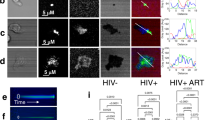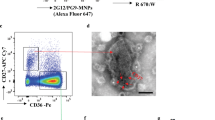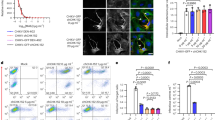Abstract
After host entry through mucosal surfaces, human immunodeficiency virus-1 (HIV-1) disseminates to lymphoid tissues to establish a generalized infection of the immune system. The mechanisms by which this virus spreads among permissive target cells locally during the early stages of transmission and systemically during subsequent dissemination are not known1. In vitro studies suggest that the formation of virological synapses during stable contacts between infected and uninfected T cells greatly increases the efficiency of viral transfer2. It is unclear, however, whether T-cell contacts are sufficiently stable in vivo to allow for functional synapse formation under the conditions of perpetual cell motility in epithelial3 and lymphoid tissues4. Here, using multiphoton intravital microscopy, we examine the dynamic behaviour of HIV-infected T cells in the lymph nodes of humanized mice. We find that most productively infected T cells migrate robustly, resulting in their even distribution throughout the lymph node cortex. A subset of infected cells formed multinucleated syncytia through HIV envelope-dependent cell fusion. Both uncoordinated motility of syncytia and adhesion to CD4+ lymph node cells led to the formation of long membrane tethers, increasing cell lengths to up to ten times that of migrating uninfected T cells. Blocking the egress of migratory T cells from the lymph nodes into efferent lymph vessels, and thus interrupting T-cell recirculation, limited HIV dissemination and strongly reduced plasma viraemia. Thus, we have found that HIV-infected T cells are motile, form syncytia and establish tethering interactions that may facilitate cell-to-cell transmission through virological synapses. Migration of T cells in lymph nodes therefore spreads infection locally, whereas their recirculation through tissues is important for efficient systemic viral spread, suggesting new molecular targets to antagonize HIV infection.
This is a preview of subscription content, access via your institution
Access options
Subscribe to this journal
Receive 51 print issues and online access
$199.00 per year
only $3.90 per issue
Buy this article
- Purchase on Springer Link
- Instant access to full article PDF
Prices may be subject to local taxes which are calculated during checkout




Similar content being viewed by others
References
Haase, A. T. Early events in sexual transmission of HIV and SIV and opportunities for interventions. Annu. Rev. Med. 62, 127–139 (2011)
Sattentau, Q. Avoiding the void: cell-to-cell spread of human viruses. Nature Rev. Microbiol. 6, 815–826 (2008)
Gebhardt, T. et al. Different patterns of peripheral migration by memory CD4+ and CD8+ T cells. Nature 477, 216–219 (2011)
Mempel, T. R., Henrickson, S. E. & von Andrian, U. H. T-cell priming by dendritic cells in lymph nodes occurs in three distinct phases. Nature 427, 154–159 (2004)
Melkus, M. W. et al. Humanized mice mount specific adaptive and innate immune responses to EBV and TSST-1. Nature Med. 12, 1316–1322 (2006)
Denton, P. W. et al. Antiretroviral pre-exposure prophylaxis prevents vaginal transmission of HIV-1 in humanized BLT mice. PLoS Med. 5, e16 (2008)
Sun, Z. et al. Intrarectal transmission, systemic infection, and CD4+ T cell depletion in humanized mice infected with HIV-1. J. Exp. Med. 204, 705–714 (2007)
Brainard, D. M. et al. Induction of robust cellular and humoral virus-specific adaptive immune responses in human immunodeficiency virus-infected humanized BLT mice. J. Virol. 83, 7305–7321 (2009)
von Andrian, U. H. & Mempel, T. R. Homing and cellular traffic in lymph nodes. Nature Rev. Immunol. 3, 867–878 (2003)
Worbs, T., Mempel, T. R., Bolter, J., von Andrian, U. H. & Forster, R. CCR7 ligands stimulate the intranodal motility of T lymphocytes in vivo. J. Exp. Med. 204, 489–495 (2007)
Bajénoff, M. et al. Stromal cell networks regulate lymphocyte entry, migration, and territoriality in lymph nodes. Immunity 25, 989–1001 (2006)
Schindler, M., Munch, J. & Kirchhoff, F. Human immunodeficiency virus type 1 inhibits DNA damage-triggered apoptosis by a Nef-independent mechanism. J. Virol. 79, 5489–5498 (2005)
Chen, B. K., Gandhi, R. T. & Baltimore, D. CD4 down-modulation during infection of human T cells with human immunodeficiency virus type 1 involves independent activities of vpu, env, and nef. J. Virol. 70, 6044–6053 (1996)
Zhang, Z. et al. Sexual transmission and propagation of SIV and HIV in resting and activated CD4+ T cells. Science 286, 1353–1357 (1999)
Stolp, B. et al. HIV-1 Nef interferes with host cell motility by deregulation of Cofilin. Cell Host Microbe 6, 174–186 (2009)
Nobile, C. et al. HIV-1 Nef inhibits ruffles, induces filopodia, and modulates migration of infected lymphocytes. J. Virol. 84, 2282–2293 (2010)
Brown, A., Gartner, S., Kawano, T., Benoit, N. & Cheng-Mayer, C. HLA-A2 down-regulation on primary human macrophages infected with an M-tropic EGFP-tagged HIV-1 reporter virus. J. Leukoc. Biol. 78, 675–685 (2005)
Casartelli, N. et al. Tetherin restricts productive HIV-1 cell-to-cell transmission. PLoS Pathog. 6, e1000955 (2010)
Llewellyn, G. N., Hogue, I. B., Grover, J. R. & Ono, A. Nucleocapsid promotes localization of HIV-1 gag to uropods that participate in virological synapses between T cells. PLoS Pathog. 6, e1001167 (2010)
Jolly, C., Kashefi, K., Hollinshead, M. & Sattentau, Q. J. HIV-1 cell to cell transfer across an Env-induced, actin-dependent synapse. J. Exp. Med. 199, 283–293 (2004)
Chen, P., Hubner, W., Spinelli, M. A. & Chen, B. K. Predominant mode of human immunodeficiency virus transfer between T cells is mediated by sustained Env-dependent neutralization-resistant virological synapses. J. Virol. 81, 12582–12595 (2007)
Hübner, W. et al. Quantitative 3D video microscopy of HIV transfer across T cell virological synapses. Science 323, 1743–1747 (2009)
Rudnicka, D. et al. Simultaneous cell-to-cell transmission of human immunodeficiency virus to multiple targets through polysynapses. J. Virol. 83, 6234–6246 (2009)
Sodroski, J., Goh, W. C., Rosen, C., Campbell, K. & Haseltine, W. A. Role of the HTLV-III/LAV envelope in syncytium formation and cytopathicity. Nature 322, 470–474 (1986)
Arthos, J. et al. HIV-1 envelope protein binds to and signals through integrin α4β7, the gut mucosal homing receptor for peripheral T cells. Nature Immunol. 9, 301–309 (2008)
Thali, M. et al. Effects of changes in gp120–CD4 binding affinity on human immunodeficiency virus type 1 envelope glycoprotein function and soluble CD4 sensitivity. J. Virol. 65, 5007–5012 (1991)
Sowinski, S. et al. Membrane nanotubes physically connect T cells over long distances presenting a novel route for HIV-1 transmission. Nature Cell Biol. 10, 211–219 (2008)
Sherer, N. M. et al. Retroviruses can establish filopodial bridges for efficient cell-to-cell transmission. Nature Cell Biol. 9, 310–315 (2007)
Kersh, E. N. et al. Evaluation of the lymphocyte trafficking drug FTY720 in SHIVSF162P3-infected rhesus macaques. J. Antimicrob. Chemother. 63, 758–762 (2009)
Brainard, D. M. et al. Induction of robust cellular and humoral virus-specific adaptive immune responses in human immunodeficiency virus-infected humanized BLT mice. J. Virol. 83, 7305–7321 (2009)
Schindler, M. et al. Down-modulation of mature major histocompatibility complex class II and up-regulation of invariant chain cell surface expression are well-conserved functions of human and simian immunodeficiency virus nef alleles. J. Virol. 77, 10548–10556 (2003)
Hwang, S. S., Boyle, T. J., Lyerly, H. K. & Cullen, B. R. Identification of the envelope V3 loop as the primary determinant of cell tropism in HIV-1. Science 253, 71–74 (1991)
Mostoslavsky, G., Fabian, A. J., Rooney, S., Alt, F. W. & Mulligan, R. C. Complete correction of murine Artemis immunodeficiency by lentiviral vector-mediated gene transfer. Proc. Natl Acad. Sci. USA 103, 16406–16411 (2006)
Pirounaki, M., Heyden, N. A., Arens, M. & Ratner, L. Rapid phenotypic drug susceptibility assay for HIV-1 with a CCR5 expressing indicator cell line. J. Virol. Methods 85, 151–161 (2000)
Bondanza, A. et al. Suicide gene therapy of graft-versus-host disease induced by central memory human T lymphocytes. Blood 107, 1828–1836 (2006)
Casartelli, N. et al. Tetherin restricts productive HIV-1 cell-to-cell transmission. PLoS Pathog. 6, e1000955 (2010)
Debes, G. F. et al. Chemokine receptor CCR7 required for T lymphocyte exit from peripheral tissues. Nature Immunol. 6, 889–894 (2005)
Casola, S. et al. B cell receptor signal strength determines B cell fate. Nature Immunol. 5, 317–327 (2004)
Schwab, S. R. & Cyster, J. G. Finding a way out: lymphocyte egress from lymphoid organs. Nature Immunol. 8, 1295–1301 (2007)
Murooka, T. T. & Mempel, T. R. Multiphoton intravital microscopy to study lymphocyte motility in lymph nodes. Methods Mol. Biol. 757, 247–257 (2012)
Acknowledgements
We thank J. Sodroski for the pSVIIIexE7 plasmid and A. Brown for HIV SF162R3; H. S. Shin, T. Tivey, K. Bankert and S. Tanno for technical assistance with the generation of humanized mice; A. Peixoto and D. Alvarez for management of the BL2+ multiphoton microscopy facility; A. Brass, T. Allen and T. Dudek for assistance with virological techniques; and N. Elpek, M. Byrne and A. Finzi for technical assistance. Funding for this study was through National Institutes of Health (NIH) grants P01 AI0178897, R56 AI097052, R01 CA150975 and P30 AI060354, and a Platform Award from the Ragon Institute of Massachusetts General Hospital (MGH), Massachusetts Institute of Technology (MIT) and Harvard. T.T.M. was supported by the MGH ECOR Tosteson Postdoctoral Fellowship Award and NIH training grant T32 AI007387.
Author information
Authors and Affiliations
Contributions
T.T.M., M.D. and T.R.M. performed all experiments. F.M. developed software for data analysis. E.S. and V.D.V. generated humanized mice. A.M.T., A.D.L. and U.H.v.A. contributed to the overall study design. T.T.M. and T.R.M. designed the experiments and wrote the manuscript.
Corresponding author
Ethics declarations
Competing interests
The authors declare no competing financial interests.
Supplementary information
Supplementary Information
This file contains Supplementary Figures 1-10 and Supplementary Video legends for Supplementary Videos 1-11 (see separate zipped files for Supplementary Video files). (PDF 1451 kb)
Supplementary Movies
This file contains Supplementary Movies 1-4 (see Supplementary Information for legends). (ZIP 22069 kb)
Supplementary Movies
This file contains Supplementary Movies 5-8 (see Supplementary Information for legends). (ZIP 21415 kb)
Supplementary Movies
This file contains Supplementary Movies 9-11 (see Supplementary Information for legends). (ZIP 13808 kb)
Rights and permissions
About this article
Cite this article
Murooka, T., Deruaz, M., Marangoni, F. et al. HIV-infected T cells are migratory vehicles for viral dissemination. Nature 490, 283–287 (2012). https://doi.org/10.1038/nature11398
Received:
Accepted:
Published:
Issue Date:
DOI: https://doi.org/10.1038/nature11398
This article is cited by
-
Role of microglia in HIV-1 infection
AIDS Research and Therapy (2023)
-
PEDV infection in neonatal piglets through the nasal cavity is mediated by subepithelial CD3+ T cells
Veterinary Research (2021)
-
The large extracellular loop of CD63 interacts with gp41 of HIV-1 and is essential for establishing the virological synapse
Scientific Reports (2021)
-
Understanding Willingness to Participate in HIV Biomedical Research: A Mixed Methods Investigation
AIDS and Behavior (2021)
-
Sensing of HIV-1 by TLR8 activates human T cells and reverses latency
Nature Communications (2020)
Comments
By submitting a comment you agree to abide by our Terms and Community Guidelines. If you find something abusive or that does not comply with our terms or guidelines please flag it as inappropriate.



